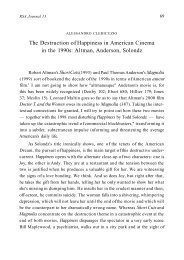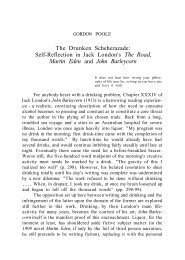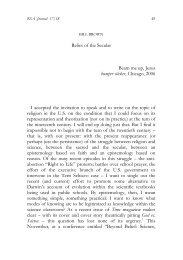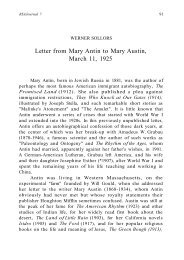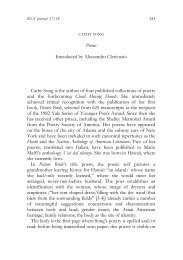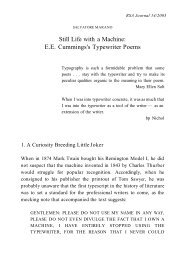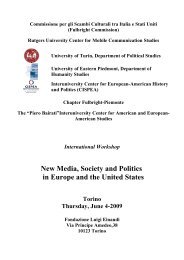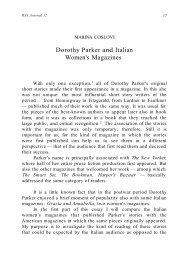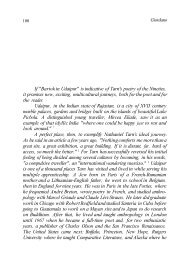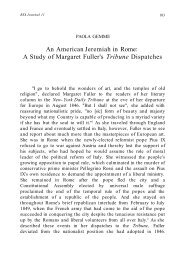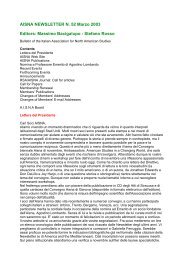Myth and Carnival in Robert Coover's The Public Burning - aisna
Myth and Carnival in Robert Coover's The Public Burning - aisna
Myth and Carnival in Robert Coover's The Public Burning - aisna
- No tags were found...
You also want an ePaper? Increase the reach of your titles
YUMPU automatically turns print PDFs into web optimized ePapers that Google loves.
RSA Journal 39order, hypostatized as totalitarian ideology, that structures language<strong>and</strong> society through the cont<strong>in</strong>uous <strong>and</strong> spectacular suppression ofdifference (the "other plot" of the Rosenbergs). A myth is born as afiction, but its fictional nature is soon forgotten. Forgetfulness posesthe ultimate threat to human lives. <strong>The</strong> essence of <strong>Myth</strong> is itsspectacular stag<strong>in</strong>g of ritualistic sacrifices—it is, so to speak, theconsumption of difference by fire, which achieves the f<strong>in</strong>al reconstitutionof the unity of the social (<strong>and</strong> literary) body <strong>in</strong> its ultimatemean<strong>in</strong>gfulness.Although Coover constantly denounces the tendency to mythifyfictions, nonetheless he is well aware of humanity's basic fear of chaos,In <strong>The</strong> <strong>Public</strong> Burn<strong>in</strong>g, Richard Nixon tells us that fictions are necessary"to transcend the confusions" (PB 234). Nixon's own struggle to solvethe confusion over the Rosenberg case becomes a metafictional allegoryof the human need for fictions:Raw data is paralyz<strong>in</strong>g, a nightmare, there's too much of it <strong>and</strong> man'sm<strong>in</strong>d is quickly engulfed by it. Poetry is the art of subord<strong>in</strong>at<strong>in</strong>g facts tothe imag<strong>in</strong>ation, of giv<strong>in</strong>g them shape <strong>and</strong> visibility... objectivity is animpossible illusion, a "fantastic claim"... <strong>and</strong> as an ideal perhaps evenimmoral, that only through the frankly biased <strong>and</strong> distort<strong>in</strong>g lens of artis any real grasp of the facts—not to mention Ultimate Truth—evenremotely possible. (PB 320)<strong>The</strong> "fire" of poetic imag<strong>in</strong>ation reduces the paralyz<strong>in</strong>g complexity of"raw" data <strong>and</strong> "cooks" them, reduc<strong>in</strong>g them down to organizedmean<strong>in</strong>gful units. Yet, the relationship that fiction bears to knowledgebr<strong>in</strong>gs us eventually back to Kermode's notion of "myth" as absolute<strong>and</strong> all-encompass<strong>in</strong>g epistemology <strong>and</strong> to Bakht<strong>in</strong>'s suggestion that"when the novel becomes the dom<strong>in</strong>ant genre, epistemology becomesthe dom<strong>in</strong>ant discipl<strong>in</strong>e" (Bakht<strong>in</strong> 132). To put th<strong>in</strong>gs differently, ifthere exists a "human need for pattern, <strong>and</strong> language's propensity,willy-nilly, for supply<strong>in</strong>g it" (Coover 1983, 68), the fiction-makercannot abdicate his/her role of storytell<strong>in</strong>g, s<strong>in</strong>ce the fictional model isthe only speculative paradigm for human underst<strong>and</strong><strong>in</strong>g <strong>and</strong> theorder<strong>in</strong>g of chaos. However, the "artist" must seek new narrativeforms, different from the classical novel (omniscient, l<strong>in</strong>ear, regulativeof a notion of reality...), forms which flaunt their own condition of



